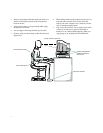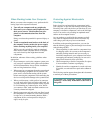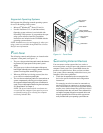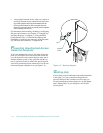
iii
Safety Instructions
When Using Your Computer System
As you use your computer system, observe the following
safety guidelines:
• To help avoid damaging your computer, be sure the
voltage selection switch on the power supply is set to
match the alternating current (AC) power available
at your location:
— 115 volts (V)/60 hertz (Hz) in most of North and
South America and some Far Eastern countries
such as Japan, South Korea, and Taiwan
— 230 V/50 Hz in most of Europe, the Middle
East, and the Far East
Also be sure your monitor and attached peripherals
are electrically rated to operate with the AC power
available in your location.
• To help prevent electric shock, plug the computer
and peripheral power cables into properly grounded
power sources. These cables are equipped with
3-prong plugs to ensure proper grounding. Do not
use adapter plugs or remove the grounding prong
from a cable. If you must use an extension cable, use
a 3-wire cable with properly grounded plugs.
• To help protect your computer system from sudden,
transient increases and decreases in electrical power,
use a surge suppressor, line conditioner, or uninter-
ruptible power supply.
• Be sure nothing rests on your computer system’s
cables and that the cables are not located where they
can be stepped on or tripped over.
• Do not spill food or liquids on your computer. If the
computer gets wet, consult your Diagnostics and
Troubleshooting Guide.
• Do not push any objects into the openings of your
computer. Doing so can cause fire or electric shock
by shorting out interior components.
• Keep your computer away from radiators and heat
sources. Also, do not block cooling vents. Avoid
placing loose papers underneath your computer; do
not place your computer in a closed-in wall unit or
on a bed, sofa, or rug.
Ergonomic Computing Habits
For comfort and efficiency, observe the following ergo-
nomic guidelines when setting up and using your
computer system:
• Position your system so that the monitor and key-
board are directly in front of you as you work.
Special shelves are available (from Dell and other
sources) to help you correctly position your
keyboard.
• Set the monitor at a comfortable viewing distance
(usually 510 to 610 millimeters [20 to 24 inches]
from your eyes).
• Make sure the monitor screen is at eye level or
slightly lower when you are sitting in front of the
monitor.
• Adjust the tilt of the monitor, its contrast and bright-
ness settings, and the lighting around you (such as
overhead lights, desk lamps, and the curtains or
blinds on nearby windows) to minimize reflections
and glare on the monitor screen.
• Use a chair that provides good lower back support.
WARNING: Improper or prolonged keyboard use
may result in injury.


















